Almost 80 years on, 10 minutes of footage taken in the Warsaw Ghetto by a young, non-Jewish Pole can be seen for the first time, in a new documentary. Its director, Eric Bednarski, laments the fact that many people still don’t know about the Holocaust
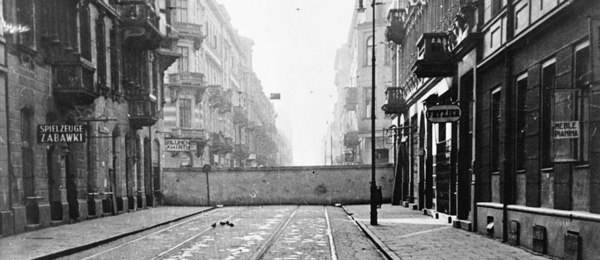
The Warsaw Ghetto wall, as seen in footage shot by Alfons Zio?kowski, in a scene from Eric Bednarski's film “Warsaw – A Divided City.”Credit: Pado Studio Films
There may be nothing more fascinating than seeing the banal and the familiar: a busy main street, pedestrians in long garments hurriedly clearing a path for themselves along the crowded sidewalk. Men in flat caps and women carrying small black leather bags or holding packages wrapped in paper flit by the camera. Occasionally, they are obscured by a passing bicyclist, or by a streetcar or truck that rumbles by. Were it not for the ruins of buildings clearly visible in the background, this bustling morning scene might be set in any metropolis in the middle of the last century. But this temporary city and most of its occupants would not survive much longer.
In 1941, a young Pole named Alfons Zio?kowski shot 10 minutes of 8-mm. film in the Warsaw Ghetto. For nearly 80 years, this reel of film languished in a dusty box in a Polish apartment. Now, the never-before-screened footage has been woven into a new documentary by Canadian director Eric Bednarski, entitled “Warsaw – A City Divided.”
“I heard rumors in my family that a distant relative somehow managed to shoot footage in the ghetto, which afterward passed to his descendants,” Bednarski, who is 43, told me last month. The Canadian-born filmmaker was visiting Israel to present his documentary as part of the Jewish Film Festival at the Jerusalem Cinematheque, and as a guest of the Polish Institute in Tel Aviv.
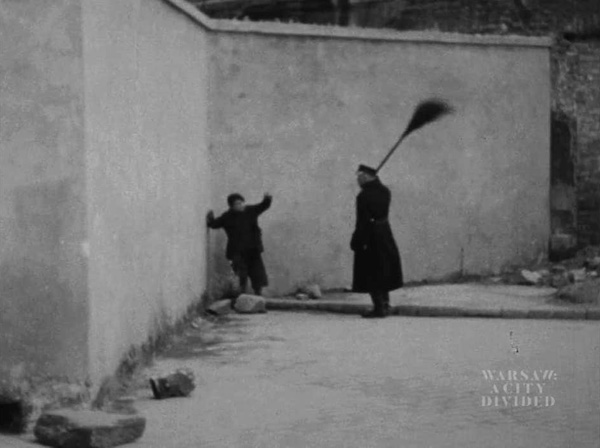
A Warsaw Blue policeman hits a child caught smuggling into the Ghetto, as seen in footage shot by Alfons Zio?kowski, in a scene from Eric Bednarski's film “Warsaw – A Divided City."Credit: Pado Studio Films
Initially, Bednarski found it hard to believe that a non-Jewish Pole had been able to enter the ghetto with a movie camera. But when he tracked down Zio?kowski’s descendants, “they confirmed that such a film exists and they showed it to me.”
It took several years for Bednarski, who studied filmmaking in Denmark and has lived in Warsaw for the past decade, to persuade the current owners of the footage to let him copy it and show it publicly.
“I knew I had a tremendous responsibility,” he says. “This material stays with you. In contrast to the familiar gaze of Nazi propaganda, this is more of a documentary approach. The people look relaxed, they are smiling at the camera, sometimes they are playing. You could say it’s a new perspective of looking at the ghetto, because [Zio?kowski] wasn’t a Jewish victim or a Nazi perpetrator – he was something of an outsider.”
A trailer for "Warsaw – A City Divided."
The precious footage almost didn’t survive the passage of the years. “When we had the reel scanned, in London, to transfer it to a higher resolution, the technician who worked on it said, ‘You know, it’s going to fall apart any second,’” Bednarski relates. “The original is very scratchy and grainy, but after it was cleaned up, we were able to see faces and streets and details that no one had seen before.”
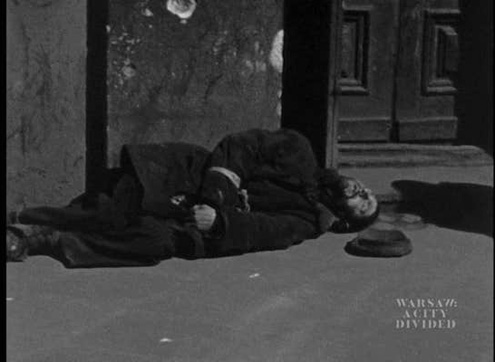
A scene from footage shot by Alfons Zio?kowski, as seen in Eric Bednarski's film “Warsaw – A Divided City.”Credit: Pado Studio Films
Among the scenes that left a lasting impression on Bednarski were a Polish policeman hitting a child, and that of desperate children smuggling bread and rhubarb stalks into the ghetto from the other side of the wall. “The [Okopowa Street] cemetery scene is also extremely powerful,” he says. “We know there were huge mass graves there – tens of thousands of people died of starvation or disease before deportations to Treblinka began in the summer of 1942. You know, the photographer saw terrible things there.”
What breaks his heart, the director adds, is the realization that the people filmed died not long afterward. He hasn’t found anyone who recognizes relatives, or themselves, in the footage.
In its 70 minutes, “Warsaw – A Divided City” tells the story of the planning, establishment and destruction of the ghetto, from its creation in November 1940 until it was eventually razed in May 1943. Apart from the singular footage he found, Bednarski drew on interviews with Holocaust survivors and leaders of the city’s Jewish community. He also uses infographic tools to depict how the Nazis executed their scheme to turn Warsaw into a German province.
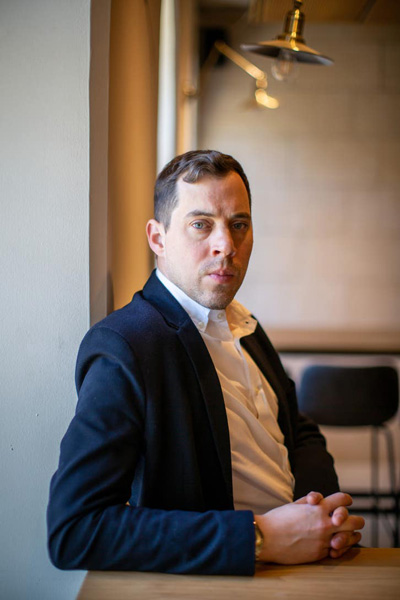
Eric Bednarski.Credit: Emil Salman
Bednarski: “My father, who is 91, is an architect who lived through the destruction of Warsaw and thorough its rebuilding. Growing up hearing his stories – and in general [growing up] with an architect – I became fascinated with cities. That was what drew me to the Nazi administration and bureaucracy. There were offices here where decisions were made about the future planning of the cities in Nazi-occupied Europe. Not only the planning of the exile and murder of the Jews, but also of the physical space itself.”
'You could say it’s a new perspective of the ghetto, because Zio?kowski wasn’t a Jewish victim or a Nazi perpetrator – he was something of an outsider.'
Other than the black-and-white segment from 1941, the documentary contains no new information for those already acquainted with the tragedy of Warsaw Jewry, which numbered some 270,000 on the eve of the war. But in an era in which the truth is being undermined, it’s important to evoke even well-known stories.
“In some ways, my film is a film about a film,” Bednarski says. “I wanted to put the footage I found into context, like a kind of guide to occupied Warsaw. When I started to work on it, people said to me, ‘What – another film about the ghetto? But everyone knows everything.’ The sad fact is that a lot of people, especially young people, don’t know about the Holocaust. Even after the screening in Warsaw, viewers told me they had no idea the ghetto was that big.”

A building that was part of the Warsaw Ghetto. From Eric Bednarski's film “Warsaw – A Divided City.”Credit: Pado Studio Films
According to Efrat Komisar, head of the film footage department of the archives at Jerusalem's Yad Vashem Holocaust memorial, the lost footage bears historical importance.
“There is not much filmed material from the ghetto,” she notes, “so any new visual material is significant ... The footage opens with a segment that shows children smuggling in food from outside the ghetto. A small hand pops up and someone takes the food. We can’t be sure that these are Jewish children. The photographer focuses on many other subjects as well: the passing trams, refugees arriving in the ghetto, street peddlers, musicians playing, and the intersection of Ch?odna and Zelazna streets, where Jews crossed between the big ghetto and the little ghetto before the wooden bridge was built.”
For professional reasons Bednarski chose not to go into details about the identity of the relative who shot the ghetto footage. But Zio?kowski’s background and identity are of considerable importance. According to a caption in the film, he was a merchant, a race-car driver and an amateur filmmaker; perhaps the fact that he was known because of his success in racing helped him get into the ghetto with a camera.
“There are two main types of footage from the Warsaw Ghetto,” Komisar explains. “Propaganda films, which were goal-focused and whose importance as historical documentation is very specific, and footage shot by private people who entered the ghetto, generally German soldiers. One of the most interesting films in the Yad Vashem collection was taken by Rudolf Bohlmann, a civilian employee of the Wehrmacht who as far as is known was anti-Nazi and who said he asked for special permission to enter the ghetto. And now, for the first time, we also have material shot by a Pole. It is the only footage I know of, including what exists in other archives, taken by a Pole. By the way, we have no footage shot by Jews in the ghetto."

The hands of Warsaw Ghetto survivor Krystyna Budnicka and Warsaw urban historian Zygmunt Walkowski as they examine a map of pre-War Warsaw. From Eric Bednarski's film “Warsaw – A Divided City.”Credit: Pado Studio Films
In contrast to propaganda films, “in which the photographer was given guidelines,” in private films, “it was each photographer and his story,” Komisar relates. “There are those who came to document and had an empathetic eye, those who were curious and those who wanted to show the Jew as ugly. Is it possible to know from the result who the photographer was? I’m not sure. It’s hard to say whether Zio?kowski is empathetic or not, but there is something unsensational about him. He doesn’t focus on bodies, dirt or squalor. He observes the street as a living space.”
The synagogue on Okopowa Street is one of the interesting subjects captured in the film, she adds: “After years of trying to figure out whether what we see in Bohlmann’s film is the bottom part of the synagogue, suddenly it’s seen in all its glory. And also the gate of the adjacent cemetery.”
Frightening World
Like Zio?kowski, Bednarski also adopts the viewpoint of the non-Jewish Pole, as is apparent, for example, in his almost complete avoidance of themes such as Polish anti-Semitism in the film. His focus is largely on German responsibility for what happened in Warsaw. He also doesn’t delve into the deeper photographic significance of such images from the ghetto, or dwell on the cinematic and visual importance of the footage he discovered, which prompted the making of his documentary.
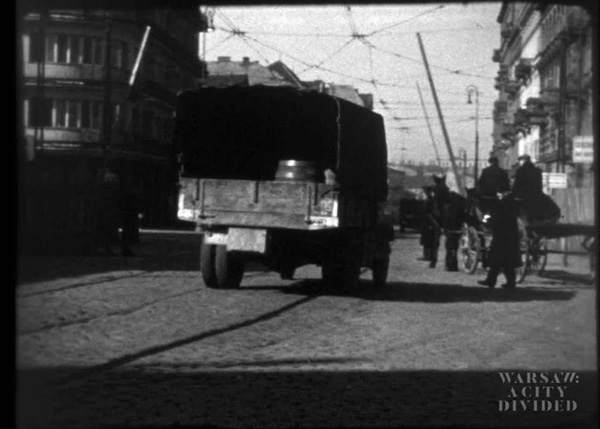
A scene from footage shot by Alfons Zio?kowski, as seen in Eric Bednarski's film “Warsaw – A Divided City.”Credit: Pado Studio Films
“I wanted to show the official Nazi layer, because it was the Nazi Germans who created the ghetto,” Bednarski explains. “The ghetto hadn’t existed beforehand. Of course, there was anti-Semitism in Warsaw before the war and during the war and after the war, and there are still some anti-Semites today. But most non-Jewish Poles had hardly any contact with the Jews in the ghetto, if at all. At the same time, there were Poles who denounced their neighbors who hid Jews, and one of the testimonies in the film shows that. I also show the policeman from the [Polish] Blue Police who beats the boy. But there are also films showing policemen who helped smuggle food. It’s extremely complex, I would say. I wanted to focus on the stories of the Jews, on Nazi planning and on the story of the city as a whole.”
For me as an Israeli viewer, the film evokes the reality of the separation barrier in the territories, the occupation, crossing points, a people living in disconnect from the world, and military control. Bednarski is surprised when he’s asked about this perspective. “I started this film about 10 years ago; the things you mentioned may have been less on my radar then,” he says. “I think those are pretty hot topics, and I prefer to stick to the film itself. What I can say is that there are divided cities everywhere, like Belfast and Nicosia, and even growing up in Canada, there were big divisions.
“I think different people will get different things from this film,” he continues. “In Canada we treated the native peoples pretty badly, they were separated and isolated, so maybe a First Nations person watching the film in Canada might see a similarity to his experience. These are people who were here 14,000 years before Canada was created.
“I don’t want to push my film on anyone, but we live in a pretty scary world,” he says. “There are still walls separating people in every corner of the world. On the other hand, the fact that I am screening the film in the Jewish state and at Yad Vashem is very moving for me.”